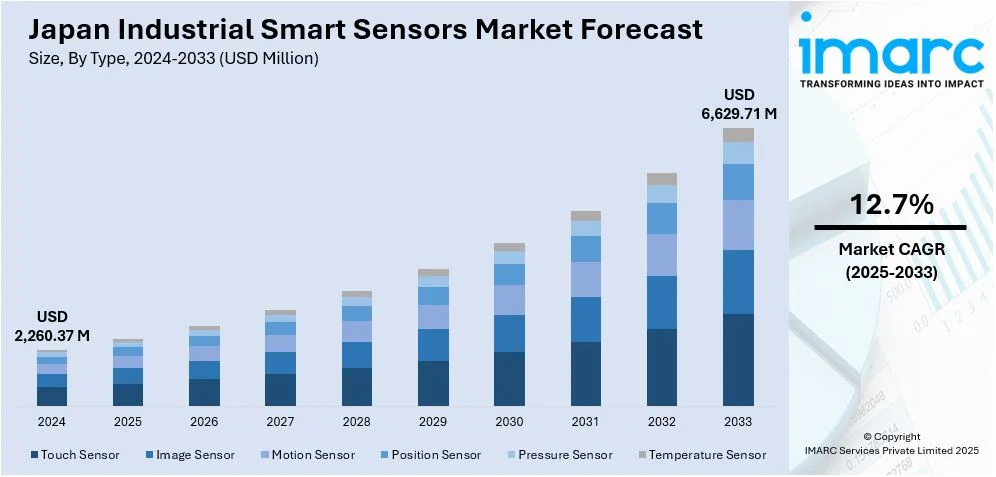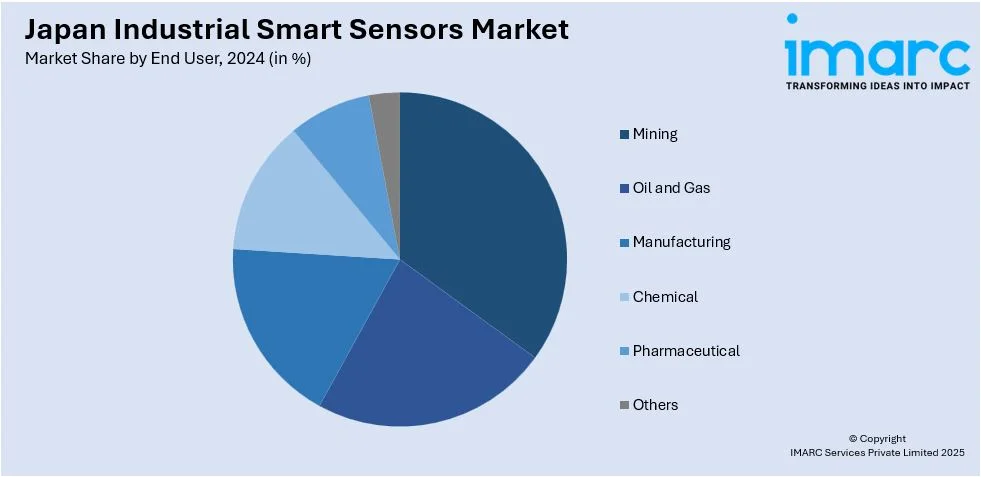
Japan Industrial Smart Sensors Market Size, Share, Trends and Forecast by Type, End User, and Region, 2025-2033
Japan Industrial Smart Sensors Market Overview:
The Japan industrial smart sensors market size reached USD 2,260.37 Million in 2024. Looking forward, IMARC Group expects the market to reach USD 6,629.71 Million by 2033, exhibiting a growth rate (CAGR) of 12.7% during 2025-2033. Rising adoption of industrial automation and the growing implementation of Industry 4.0 technologies in different industries such as automotive and manufacturing are some of the trends boosting Japan industrial smart sensors market share. Increasing need for improved efficiency, real-time data acquisition, and predictive maintenance also drives market growth.
|
Report Attribute
|
Key Statistics
|
|---|---|
|
Base Year
|
2024
|
|
Forecast Years
|
2025-2033
|
|
Historical Years
|
2019-2024
|
| Market Size in 2024 | USD 2,260.37 Million |
| Market Forecast in 2033 | USD 6,629.71 Million |
| Market Growth Rate 2025-2033 | 12.7% |
Japan Industrial Smart Sensors Market Trends:
Rising Demand for Intelligent Monitoring Solutions
Intelligent sensing technologies are being more widely used in Japan's industrial sectors. Manufacturers are progressively integrating advanced sensors into their production systems to increase real-time monitoring, operational efficiency, and predictive maintenance. These technologies are becoming increasingly important in controlling complicated machinery, assuring product quality, and reducing interruptions. The push for smart manufacturing and digital transformation has accelerated integration, with a clear move away from traditional monitoring systems. As companies strive for increased automation and data-driven decision-making, these sensors play a critical role in connecting equipment, gathering performance insights, and optimizing operations. The growing emphasis on energy management, worker safety, and precise control is broadening the application base. From autos to electronics, the usage of these technologies is expanding as businesses prioritize dependability and responsiveness in their operations. This initiative is altering Japan's industrial environment by integrating intelligence deeper into its production infrastructure. These factors are intensifying the Japan industrial smart sensors market growth. For example, Japan smart sensor market size reached USD 4.8 Billion in 2024. Looking forward, IMARC Group expects the market to reach USD 119.9 Billion by 2033, exhibiting a growth rate (CAGR) of 43% during 2025-2033.

Growing Integration of AI with Industrial Sensing
Japan is rapidly merging AI and smart sensing technologies to build more adaptable and responsive industrial settings. The emphasis is shifting from simple monitoring to systems that analyze real-time data to provide predicted insights and automated control. Biometric recognition, environmental mapping, and intelligent automation are increasingly being used in large-scale venues and infrastructure, rather than just factories. This progress contributes to increased efficiency, safety, and system coordination across industries. AI integration enables sensors to give more than just raw data, transforming them into active decision-making and process management tools. As these technologies gain traction, Japan's industrial environment shifts toward more connected, intelligent, and agile operations centered on data-driven systems. For instance, Panasonic Connect will be implementing AI-driven sensing and recognition technologies such as biometric systems and projection mapping at Expo 2025 Osaka, Kansai, from 13 April to 13 October 2025. The move reflects Japan's drive toward industrial smart sensing, pairing real-time data capture with AI processing. It reflects Panasonic's commitment to enhancing intelligent sensor applications in large-scale settings, in line with the overall expansion of Japan's industrial smart sensors market.
Japan Industrial Smart Sensors Market Segmentation:
IMARC Group provides an analysis of the key trends in each segment of the market, along with forecasts at the country and regional levels for 2025-2033. Our report has categorized the market based on type and end user.
Type Insights:
- Touch Sensor
- Image Sensor
- Motion Sensor
- Position Sensor
- Pressure Sensor
- Temperature Sensor
The report has provided a detailed breakup and analysis of the market based on the type. This includes touch sensor, image sensor, motion sensor, position sensor, pressure sensor, and temperature sensor.
End User Insights:

- Mining
- Oil and Gas
- Manufacturing
- Chemical
- Pharmaceutical
- Others
A detailed breakup and analysis of the market based on the end user have also been provided in the report. This includes mining, oil and gas, manufacturing, chemical, pharmaceutical, and others.
Regional Insights:
- Kanto Region
- Kansai/Kinki Region
- Central/Chubu Region
- Kyushu-Okinawa Region
- Tohoku Region
- Chugoku Region
- Hokkaido Region
- Shikoku Region
The report has also provided a comprehensive analysis of all the major regional markets, which include Kanto Region, Kansai/Kinki Region, Central/Chubu Region, Kyushu-Okinawa Region, Tohoku Region, Chugoku Region, Hokkaido Region, and Shikoku Region.
Competitive Landscape:
The market research report has also provided a comprehensive analysis of the competitive landscape. Competitive analysis such as market structure, key player positioning, top winning strategies, competitive dashboard, and company evaluation quadrant has been covered in the report. Also, detailed profiles of all major companies have been provided.
Japan Industrial Smart Sensors Market News:
- In March 2025, Mitsubishi Heavy Industries and MHI Machinery Systems developed a Merging Support Information System using vehicle detection sensors and roadside processing units for Japan’s first autonomous truck trial on the Shin-Tomei Expressway. The system enables real-time traffic monitoring and data transmission to trucks, aiding safe highway merging. This deployment showcases Japan’s advancement in smart sensor infrastructure supporting autonomous mobility and intelligent transport systems.
Japan Industrial Smart Sensors Market Report Coverage:
| Report Features | Details |
|---|---|
| Base Year of the Analysis | 2024 |
| Historical Period | 2019-2024 |
| Forecast Period | 2025-2033 |
| Units | Million USD |
| Scope of the Report |
Exploration of Historical Trends and Market Outlook, Industry Catalysts and Challenges, Segment-Wise Historical and Future Market Assessment:
|
| Types Covered | Touch Sensor, Image Sensor, Motion Sensor, Position Sensor, Pressure Sensor, Temperature Sensor |
| End Users Covered | Mining, Oil and Gas, Manufacturing, Chemical, Pharmaceutical, Others |
| Regions Covered | Kanto Region, Kansai/Kinki Region, Central/Chubu Region, Kyushu-Okinawa Region, Tohoku Region, Chugoku Region, Hokkaido Region, and Shikoku Region |
| Customization Scope | 10% Free Customization |
| Post-Sale Analyst Support | 10-12 Weeks |
| Delivery Format | PDF and Excel through Email (We can also provide the editable version of the report in PPT/Word format on special request) |
Key Questions Answered in This Report:
- How has the Japan industrial smart sensors market performed so far and how will it perform in the coming years?
- What is the breakup of the Japan industrial smart sensors market on the basis of type?
- What is the breakup of the Japan industrial smart sensors market on the basis of end user?
- What is the breakup of the Japan industrial smart sensors market on the basis of region?
- What are the various stages in the value chain of the Japan industrial smart sensors market?
- What are the key driving factors and challenges in the Japan industrial smart sensors?
- What is the structure of the Japan industrial smart sensors market and who are the key players?
- What is the degree of competition in the Japan industrial smart sensors market?
Key Benefits for Stakeholders:
- IMARC’s industry report offers a comprehensive quantitative analysis of various market segments, historical and current market trends, market forecasts, and dynamics of the Japan industrial smart sensors market from 2019-2033.
- The research report provides the latest information on the market drivers, challenges, and opportunities in the Japan industrial smart sensors market.
- Porter's five forces analysis assist stakeholders in assessing the impact of new entrants, competitive rivalry, supplier power, buyer power, and the threat of substitution. It helps stakeholders to analyze the level of competition within the Japan industrial smart sensors industry and its attractiveness.
- Competitive landscape allows stakeholders to understand their competitive environment and provides an insight into the current positions of key players in the market.
Need more help?
- Speak to our experienced analysts for insights on the current market scenarios.
- Include additional segments and countries to customize the report as per your requirement.
- Gain an unparalleled competitive advantage in your domain by understanding how to utilize the report and positively impacting your operations and revenue.
- For further assistance, please connect with our analysts.
 Request Customization
Request Customization
 Speak to an Analyst
Speak to an Analyst
 Request Brochure
Request Brochure
 Inquire Before Buying
Inquire Before Buying




.webp)




.webp)












